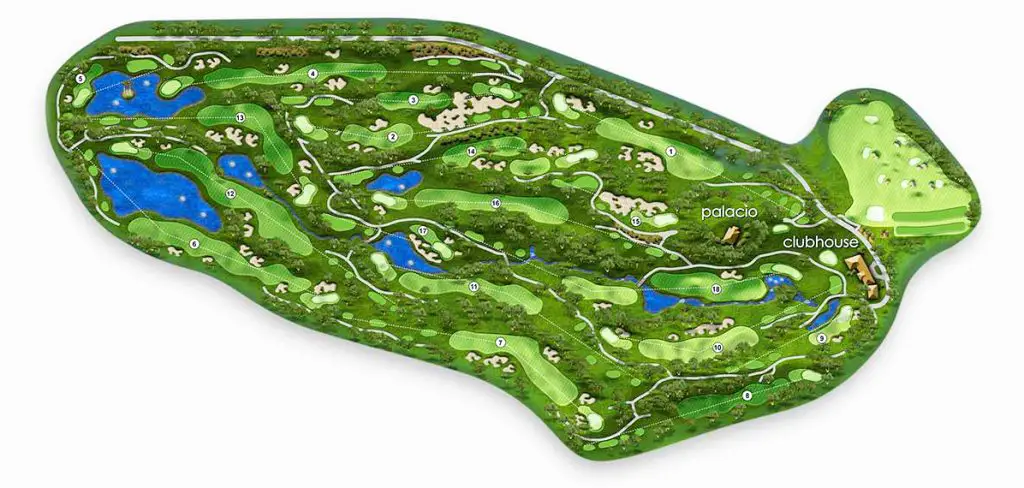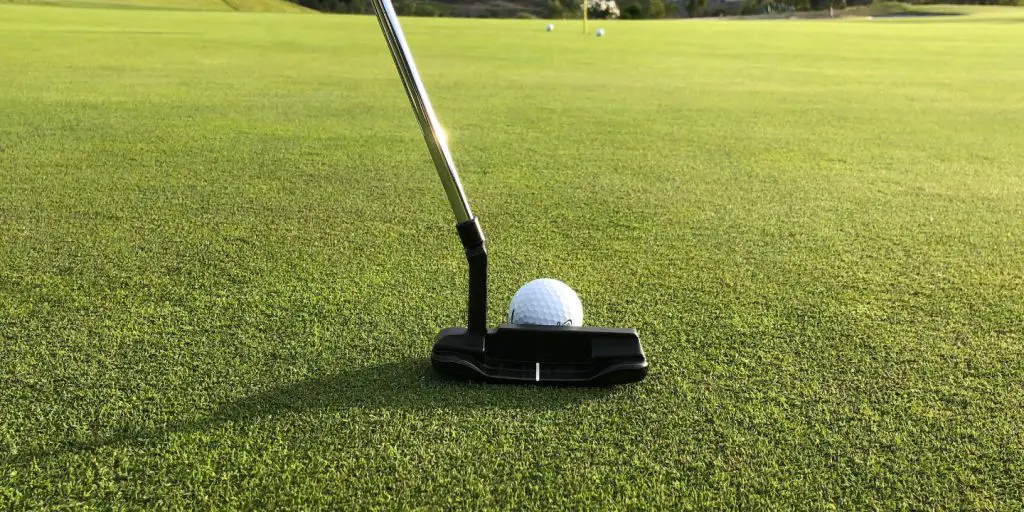Table of Contents
Tucked away in the countryside just outside of Palma de Mallorca sits Golf Son Gual, widely considered one of the top championship courses in all of Spain.
Since opening for play in 2007, Son Gual has earned a reputation for its strategic layout, immaculate conditioning, and exceptional amenities.
Its distinctive design incorporates the natural beauty of Mallorca with challenging bunkers and water hazards to test even the best players.
Course Overview

Designed by renowned German architect Thomas Himmel, Golf Son Gual stretches to over 7,100 yards from the back tees with a par of 72. Sprawling across flat, gently rolling terrain, the layout takes golfers on a diverse journey over 18 holes, each with its own character and set of challenges.
Mature pine and olive trees frame the holes, while meticulously manicured Bermuda grass covers the fairways and greens. Strategically placed bunkers and water hazards demand accuracy off the tee and precise approach shots.
With five sets of tees, Son Gual presents a stiff but fair examination for players of all levels.
Amenities and Facilities
The impressive clubhouse at Son Gual overlooks the 18th green and practice facilities, blending seamlessly into the surrounding landscape. Inside, golfers will find a pro shop stocked with high-end equipment and apparel, along with locker rooms, bag storage, and a lounge area.
Adjacent to the clubhouse lies the double-ended driving range where players can dial in their swings prior to the round. Short game practice areas include a large putting green along with an expansive chipping green and bunkers.
Electric carts are available for rental to navigate the spacious layout. After the round, golfers can relax over drinks and a Mediterranean-inspired meal at the elegant clubhouse restaurant.
Course Layout and Design
One of the defining features of the Son Gual layout is the abundance of deep, revetted bunkers that frame the fairways and greens. In total, the course boasts over 7,000 square meters of bunkering.
These require precision and shot-shaping ability to avoid and recover from. Water hazards also come into play on several holes on course 1, most notably the par-3 5th (147m) and the par-5 18th (532m) hugging a lake all down the left side.
Each nine starts relatively open and straightforward, then culminates with a strong three-hole stretch. The front nine concludes with the long par-4 7th (433m), par-4 8th, and the 200m par-3 9th.
The back nine finishes with the sweeping dogleg-right par-4 16th (433m), downhill par-3 17th (187m), and the watery 18th (532m).
Golfers must tackle each hole strategically while managing the risk-reward options.
Son Gual Course 1 Guide

Hole 1 – 420m, par 4
This starting par 4 stretches to a long distance and often plays into the prevailing wind. The ideal strategy is to hit your downhill tee shot to the right side of the fairway, which avoids a set of bunkers on the left and leaves you with a middle or short iron approach to the green. Playing downwind, this hole is reachable for longer hitters. However, into the wind it becomes a challenging par 4 requiring two solid shots to find the putting surface. The wind conditions on this opener will immediately give you a sense of how the course is playing that day. Keeping your drive on the right side and managing the wind are keys to starting your round off well.
Hole 2 – 420m, par 4
Nicknamed “Sandy Lane,” this short par 4 offers a warm-up challenge. Your tee shot must carry over the course’s largest and most visually stunning bunker complex lining the fairway. Long hitters should resist the urge to go for the green, and instead lay up short of the expansive central fairway bunker. The depressed area fronting the green makes judging your approach shot difficult. Don’t be fooled into thinking you need a short chip or pitch – select the proper club to carry onto the putting surface. Careful planning and course management are required to score well on this unique risk-reward hole.
Hole 3 – 318m, par 4
This short par 4 will test your precision and course strategy. At just 301 metres, the fairway is the shortest on the course, flanked by expansive bunkers right and more protecting the green. With a tailwind, reaching this well-guarded green in one is possible but risky. Laying up short of the fairway bunkers is advisable for most. The two-tiered green is the most difficult to putt on the course – your approach must land on the proper plateau to avoid a challenging three-putt. This hole demands thoughtful decisions and pinpoint execution to score well, truly exemplifying how golf is a game of precision. Carefully navigating the treacherous bunkers and hitting the correct portion of the green are the keys here.
Hole 4 – 507m, par5
The first par 5 on the course is reachable in two shots if you execute well. Off the tee, you must split the fairway bunkers left and right with your drive. For your second shot, the green sits on a peninsula fronted by water, requiring supreme accuracy. The ideal line is just right of center to avoid going long into trouble. Wind conditions heavily influence your strategy and club selection on the second shot. If you miss the green, getting up and down will be difficult with water lurking. As the hole’s title states, your third stroke is crucial – a deft chip or pitch is needed to save par if you misjudge your second. Keeping your ball dry and pulling off a precise third shot are the main challenges on this risk-reward par 5.
Hole 5 – 147m, par 3
The shortest hole on the course, this par 3 demands skillful club selection based on the wind. Playing only 147 metres from the back tee, the choice of right club is critical to attack the flag. Any shot not hit boldly enough will catch the deep swale right of the green and leave an extremely tough pitch over water. The sloping green runs away towards the water as well. Wind trajectory, bold shot-making, and recovery skill if you miss are all put to the test on this petite but perilous par 3. With wind factored in, precise distance judgment and dexterous touch around the green are required to walk away with par.
Hole 6 – 492m, par 5
This leftward dogleg par 5 demands skillful positioning and recovery ability. From the tee, the fairway is bisected by a lake, either requiring a risky long carry or a safe layup short. Don’t underestimate the carry distance. The second shot then needs to split deep fairway bunkers. Yardage knowledge is key. The angled, rippled green also slopes away, making the approach exacting. With water hazards, precise bunker play, and a contoured green, this hole puts a premium on recovery around the greens. Keeping the ball dry while navigating hazards and hitting an accurate third shot are imperative for success. Power is less important than finesse on this multifaceted par 5.
Hole 7 – 433m, par 4
One of the toughest par 4s on the front nine, this long dogleg right climbs uphill and requires supreme accuracy. The massive fairway bunker complex right demands a leftward drive, though long hitters can carry it as a shortcut. Approach shots must then hold the elevated green with its false front, as anything short rolls back down the slope. Navigating this narrow, ascending fairway and reaching the well-guarded green in regulation make for a difficult hole. Choosing the right club for both shots and executing solid contact is a must to score well. The seventh hole truly tests a golfer’s ball-striking and course management skills with its forced carries and unforgiving green.
Hole 8 – 354m, par 4
Despite a wide, bunkerless fairway, this par 4 is tougher than it first looks. The fairway dips through a valley lined by out-of-bounds trees right. The green is subtly raised and must be struck precisely, especially when the flag is forward. Any miss-hit chip from around the green risks rolling back down off the putting surface. With trouble lurking right and a sloping green, par is a good score here. While appearing more open, the strategic placement of trees and contours of the green make accuracy imperative. Keeping tee shots in play and dialing in iron distances is key. Though relatively short, this hole ultimately rewards thoughtful positioning and crisp shot-making.
Hole 9 – 200m, par 3
This formidable par 3 caps off the front nine and demands solid ball-striking. Playing up to 200 metres from the tips, it is the longest one-shotter on the course. A forced carry over water is required if the pin is left, but bailout room exists right. Weaker players can lay up short and rely on an accurate chip and putt for par. With water left, a massive false front, and the clubhouse looking on, this hole tests nerve and skill. The tee shot difficulty varies based on pin position and personal risk tolerance. But no matter where the flag is, precision and mental fortitude are musts if you hope to walk away with par on this challenging closing hole.
Hole 10 – 367m, par 4
Playing right in front of the clubhouse, the tenth asks for a wind-conscious tee shot left over a stream, avoiding a long bunker complex right. Approach shots must then fly high over a fronting bunker to reach the green safely. With water and sand hazards to manoeuvre, wind awareness and accurate iron play are musts. Conquering the elevated, heavily guarded green in regulation is a tough task. Keeping the ball left off the tee then hitting a precise mid-iron that holds the sloping surface makes for a strong start to the back nine. This hole demands thinking ahead and skill execution to card a good score.
Hole 11 – 423m, par 4
The par 4 eleventh stretches over 420 metres, calling for an accurate tee shot to the left portion of the fairway by the landmark baobab tree. The slightly elevated green is fronted by water and demands a heroic long iron or fairway wood that carries the hazard. With a forced carry over water and the need for length off the tee, this hole favors the big hitters. Careful positioning on the drive and sheer power on the approach are prerequisites to score well here. The landing area tightens the further you hit it, testing both strategy and skill. Only the longest and most precise players will survive this robust par 4 unscathed.
Hole 12 – 500m, par 5
Hole 12 is a par 5 that plays 500 meters from the back tees. A stream runs along the left side of the fairway, and deep bunkers guard the left side, making accuracy important off the tee. The approach shot to the green must carry over a lake on the left. The large green is 42 meters deep and protected by bunkers on the right. Laying up and playing defensively to avoid the water is usually the smarter play rather than going for the green in two shots. The hole emphasizes chipping and putting skills around the well-protected green.
Hole 13 – 429m, par 4
Hole 13 is a challenging 429-meter par 4. The ideal line off the tee is over the right side of the fairway, which is guarded by elongated bunkers. Further right is out-of-bounds water. The approach shot must carry a deep greenside bunker to reach the green. The large green has a lot of break depending on the flag position. Accuracy off the tee and proper club selection into the green are critical on this hole.
Hole 14 – 360m, par 4
Hole 14 is a 360 meter par 4 that plays uphill. Off the tee, players can either lay up left of the fairway bunker or take on the 247 meter carry over the bunker from the back tee. Laying up makes the approach longer but provides a clear view of the large, raised green. Carrying the bunker leaves a shorter shot in but the approach is semi-blind. The extensive green complex requires proper club selection and accuracy, especially when hitting a long iron or hybrid from the left side. This hole rewards bold play while providing a safer option as well.
Hole 15 – 175m, par 3
The 175-meter par 3 15th hole is one of the signature holes at Son Gual. From the expansive tee box, players have a panoramic view of the course and the old Palacio behind the green. The hole demands full concentration despite its short length. Only a perfectly struck tee shot will hold the rippling green, which is surrounded by trouble. This picturesque but challenging par 3 requires precision shotmaking to score well. The green complex and surrounding view make it one of the most scenic holes on the course.
Hole 16 – 433m, par 4
The 433-meter par 4 16th hole begins the challenging closing stretch at Son Gual. The fairway slopes downward, providing some extra distance off the tee. However, accuracy is paramount as water lines the right side and a deep bunker guards the left of the green. This long par 4 demands smart decisions and precise shots. Any wayward drive or approach will be penalized. The rolling fairway and green complex require flawless execution to score well. This hole presents a stiff test prior to the final two holes.
Hole 17 – 187m, par 3
The difficult 187-meter par 3 17th hole plays over water and front right bunkers. The prevailing wind can affect tee shots so club selection is important. Longer hitters can aim at the flag, but higher handicappers may prefer bailing out left and pitching on. Shots hit too long end up in two deep back bunkers. With water front and bunkers behind, just getting on the green in regulation is an accomplishment. Bogey is not a bad score on this challenging late par 3.
Hole 18 – 532m, par 5
The 532-meter par 5 18th hole is the longest at Son Gual and provides a dramatic finish. Off the tee, the landing zone is tighter on the right due to a fairway bunker, but it provides the better angle of approach. A stream winds diagonally across the fairway and must be carried on the second shot. The approach is then made over a lake to a green set right below the clubhouse terrace. Only bold, accurate shots will reach this green in two to set up an eagle chance. The water hazards and spectators on the terrace add pressure during the closing hole. It’s a demanding par 5 that makes for an exhilarating finish.
Hole Distance, Par & Handicap
| Hole | Distance (m) | Par | Handicap |
|---|---|---|---|
| 1 | 420 | 4 | 7 |
| 2 | 344 | 4 | 15 |
| 3 | 318 | 4 | 13 |
| 4 | 507 | 5 | 11 |
| 5 | 147 | 3 | 5 |
| 6 | 492 | 5 | 9 |
| 7 | 433 | 4 | 1 |
| 8 | 354 | 4 | 17 |
| 9 | 200 | 3 | 3 |
| 10 | 367 | 4 | 10 |
| 11 | 423 | 4 | 4 |
| 12 | 500 | 5 | 14 |
| 13 | 429 | 4 | 12 |
| 14 | 360 | 4 | 16 |
| 15 | 175 | 3 | 18 |
| 16 | 433 | 4 | 6 |
| 17 | 187 | 3 | 8 |
| 18 | 532 | 5 | 2 |
Playing Experience
From the first tee, the quality of Son Gual is apparent through the meticulous course conditions and attention to detail. While challenging, the course sets up fairly without overly punishing or tricking golfers.
The par-4s demand solid tee shots and precise approach irons to tiered greens. Par-3s range from short to mid-length, each requiring a well-executed shot to avoid bunkers or water.
On par-5s, shorter hitters can play conservatively to reach in three, while aggressive players may attempt to reach the green in two with risk.
With spacious fairways and typically breezy conditions, the course plays firmly but fair. The smooth, undulating greens run at a medium pace.
A premium is placed on crisp iron play and lag putting. Varied pin placements allow the grounds staff to fine-tune the difficulty.
Golfers of all abilities are able to enjoy their round.
Conditions and Maintenance

Meticulous maintenance and working with the natural environment are hallmarks of Golf Son Gual. Year-round sunshine and his knowledge of agronomy allow course superintendent Pedro to keep the course in pristine condition.
The fairways provide lush lies while the greens are smooth and consistent. Even during the peak summer season, the conditions meet expectations for a high-end club.
From tee to green, Son Gual exhibits a refinement not found at many other courses on the island.
Scenery and Atmosphere
The natural beauty of Mallorca shines through at Golf Son Gual, surrounded by mature forests and farmland. Each hole has its own personality with different vistas that capture the essence of the island.
There is a peaceful, relaxed atmosphere throughout the property. While planes occasionally pass over when landing at nearby Palma Airport, they do not detract from the overall tranquil setting.
The panoramic view of Palma in the distance is a highlight from the elevated clubhouse. Golfers can savour the scenery and warm climate while challenging themselves on this championship layout.
Local Knowledge and Tips
With numerous bunkers and some tight landing areas, accuracy is rewarded over pure length at Son Gual.
On approach shots, it is better to miss short than go long. The large greens allow for bump-and-run shots if you miss the green.
The prevailing breeze will push shots slightly from right to left. The par-5 9th and 18th are reachable in two with aggressive play. However, bail-out areas are available on most holes for higher handicappers.
Taking enough club to clear water hazards is advised.
Customer Service and Staff
From the pro shop staff to cart attendants to the clubhouse team, Golf Son Gual is committed to providing a first-class experience.
Staff are professional, attentive, and fluent in multiple languages.
The starting groups and overall pace are efficiently managed by the starters. Caddies are available for those looking for even more guidance around the course.
The club aims to make each golfer’s round as seamless and enjoyable as possible.
Value for Money
Green fees at Son Gual are at the upper end of the spectrum on the island, ranging from €100-€180 for 18 holes depending on the day and time of year.
While not the most budget-friendly, the combination of amenities, conditions, and guest service make it well worth the cost for a special occasion or golf trip.
The experience rivals many top-tier clubs in mainland Europe.
Discounts are also offered for multi-round packages, juniors, and members’ guests.
Overall, visitors feel they get strong value at Son Gual for a premium golf experience.
Conclusion
For travellers seeking world-class golf in Mallorca, look no further than Son Gual. This young course has matured into a refined test of target golf combining natural beauty and strategic design.
With its excellent year-round conditions and first-rate facilities, it belongs on every golfer’s itinerary when visiting the island. While the green fee demands a premium price, the total experience delivered makes Golf Son Gual a must-play.
Location
Click to show map!
Contact
Website: son-gual.com
Telephone: (+34) 971 785 888

Mark Kaye is a travel writer and content creator living in Majorca, Spain. Originally from the UK, Mark moved to the island and quickly fell in love with Majorcan culture, food, and scenic landscapes. When he’s not busy writing detailed guides about Majorca’s top tourist attractions and hidden local gems, you can find him out exploring coastal trails or wandering the streets of Palma’s Old Town in search of his next great restaurant discovery.








